For our tour description, itinerary, past triplists, dates, fees, and more, please VISIT OUR TOUR PAGE.
See this triplist in printable PDF format with media only on page 1.
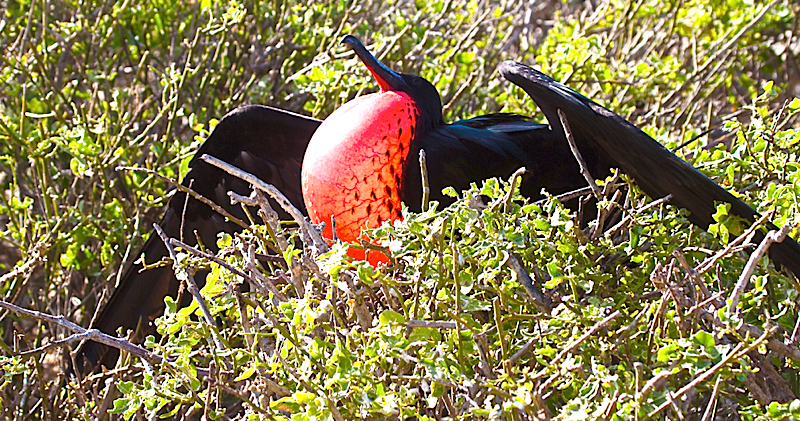
A male Great
Frigatebird puffs out his chest pouch in a breeding display on
the island of Genovesa. (Photo by guide Alvaro Jaramillo)
The Galapagos are a unique place, one of those spots that you have seen so many images of in life that it is weird and surprising to actually see the real thing. It does not disappoint; it is always different than expectations, but in the end it is always a wonderful experience. No doubt it was wonderful not only because of the great birds and wildlife, but also because of Peter Freire and the great crew of the good ship Nemo II. The food was great, and the service spectacular.
We also did particularly well in getting our custom itinerary accepted, and we were able to get to all spots that had an endemic species. We also found all of the endemics, although the Large Tree Finch was only seen by a few in the group. We tried hard to find another, and it just did not happen. But our luck earlier that day with rails was mind-blowing!! I have never seen either the Galapagos Rail or the Paint-billed Crake that well. The Mangrove Finch gave us a run for our dolares, but in the end we found one foraging down at eye level and it gave us great views. All of the expected seabirds were in evidence, including some nice deep-water pelagics like the Band-rumped Storm-Petrel, and Galapagos Petrels. We also enjoyed amazing views of all three boobies at the colony, close fly by Red-billed Tropicbird and the spectacle that is seeing the colony of Wedge-rumped Storm-Petrels with attending Short-eared Owls, and the colony of the gentle looking Waved Albatross. Wow! I also enjoyed watching the displays, either calling Swallow-tailed Gulls, the Great Frigatebirds with pouches fully inflated, or the foot dance of the Blue-footed Boobies. It was cool to say the least.
Our experience with finches was a good one; we had great views of almost all of them, and we were able to chat about what it all means, this bill size variation in one group of birds. We thought about speciation and how it is mediated by environmental factors, and how morphological change can occur so quickly on these islands of wet and dry extremes. The mockingbirds gave a different backdrop to understanding the issues involved in Natural Selection and differentiation as well.
We had a good time, a happy time, albeit a sad punctuation to our tour was finding out that Lonesome George had died the very moment we were heading out to see him! This was tragic. On the other hand we wished Diego well and noted that his star is rising. Also Diego's story is a happy one, he helped to re-populate Española Island, and in turn to save his population of tortoises. Let's hope the world has a lot more Diegos and fewer Georges.
I had a fantastic time birding with you all, and hope that we can see you on another one of our tours! Take care, and good birding to you all.
--Alvaro
For more information about this tour, including future departures, visit our website at www.fieldguides.com. And to see this same triplist online, go to https://fieldguides.com/triplists/gal12aLIST.pdf and you will find the list in its entirety.
KEYS FOR THIS LIST
One of the following keys may be shown in brackets for
individual species as appropriate: * = heard only, I =
introduced, E = endemic, N = nesting, a = austral migrant, b =
boreal migrant
BIRDS
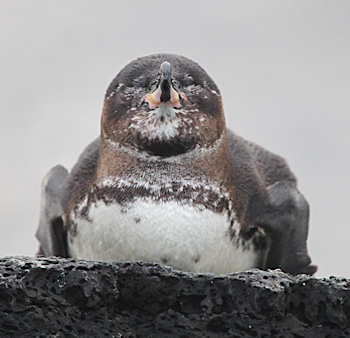
The Galapagos
Penguin is the only penguin to naturally occur north of the
equator, and is also the only species most people are ever
likely to snorkel with, as some of our group did at Punta
Moreno! (Photo by guide Alvaro Jaramillo)
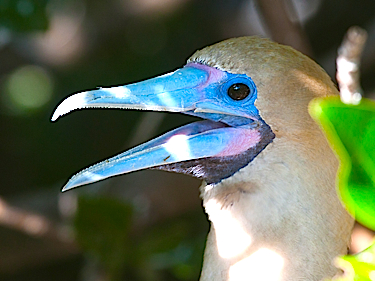
Unlike the other
two booby species that nest on the islands, the smallish
Red-footed Booby is a tree-nester. Dark morph birds, like
this one, are the more common, though white morphs also
occur in smaller numbers. (Photo by guide Alvaro Jaramillo)
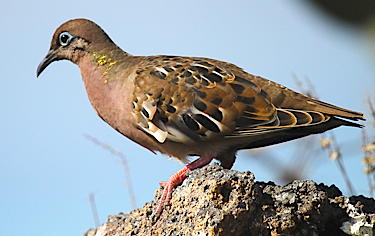
Besides finches and
mockingbirds, endemic landbirds aren't too numerous in the
islands. The lovely Galapagos Dove, a close relative of the
widespread Eared Dove of South America, is one of the
notable exceptions. (Photo by guide Alvaro Jaramillo)
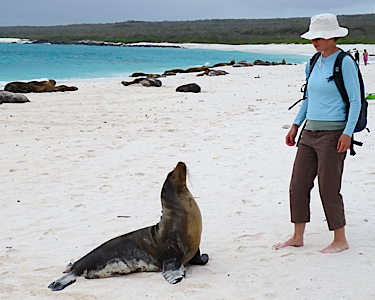
Tour participant
Heather gets a warm welcome from a "Galapagos" Sea Lion on
the island of Espanola. (Photo by guide Alvaro Jaramillo)
MAMMALS
ADDITIONAL COMMENTS
Marine iguana (Amblyrhynchus cristatus) - We saw the big subspecies, the small subspecies and those gorgeous red ones in the southern islands.
Santa Fe Land Iguana (Conolophus pallidus) - Endemic to Santa Fe where we had some nice ones.
Land Iguana (Conolophus subscristatus) - We saw this species on Santa Cruz Island, at Cerro Dragon. We found males and females.
Galapagos Lava Lizard (Microlophus albemarlensis) - The widespread lava lizard, we saw on Isabela, Santa Cruz and Santa Fe Islands.
Española Lava Lizard (Microlophus delanornis) - The big lava lizard on Española.
Floreana Lava Lizard (Microlophus grayi) - A well marked lava lizard we saw on Floreana.
San Cristobal Lava Lizard (Microlophus bivattatus) - A rather uniformly patterned lava lizard.
Española Snake (Philodryas biserialis hoodensis) - The snakes that showed up after seeing the Waved Albatross on Española.
Galapagos Snake (Alsophis dorsalis dorsalis) - the snake we saw on Santa Fe.
Green Sea Turtle (Chelonia mydas agassizi) - The only sea turtles we saw on the trip. They were relatively common and we even got to swim with them!
Galapagos Tortoise (Geochelone elephantopus porteri) - Wow! What amazing creatures the giant tortoises are. The ones we saw in Santa Cruz were fully wild and unrestrained animals.
Some of the highlight fish, others were seen by snorkelers:
Black-tip Reef Shark
Manta Ray
Mobula Ray
Diamond Ray
Bullseye Pufferfish
Halfbeaks
Flying Fish
Sally Lightfoot Crab (Grapsus grapsus)
Ghost Crab (Ocypode guadichaudii)
Fiddler Crab (Uca helleri)
Star Spider (Gaseracantha serviellei)- the spiny crab spiders we saw.
Galapagos Centipede (Scolopendra galapagensis) - The absolutely huge centipede we saw at Black Beach on Isabela.
Calvert's Saddlebags (Tramea calverti) - the common dragonfly.
Large Painted Locust (Schistocerca melanocera) - the big colorful grasshopper.
Darwin's Bee (Xylocopa darwinii) - common.
Crimson Speckled Footman Moth (Utethesia ornatrix) - the white and pink moth we saw on the last days.
Galapagos Sulphur Butterfly (Phoebis sennae marcellina) - seen a few times.
Queen Butterfly (Danaus gilippus) - on Santa Cruz.
Galapagos Blue Butterly (Leptodes parrhasioides) - a few towards the end of the tour.
Totals for the tour: 69 bird taxa and 3 mammal taxa
